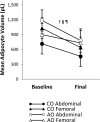The age of obesity onset affects changes in subcutaneous adipose tissue macrophages and T cells after weight loss
- PMID: 40831565
- PMCID: PMC12358274
- DOI: 10.3389/fimmu.2025.1601847
The age of obesity onset affects changes in subcutaneous adipose tissue macrophages and T cells after weight loss
Abstract
Introduction: Adipose tissue inflammation, driven in part by immune cells, may contribute to the elevated type 2 diabetes risk in adults with childhood-onset obesity (CO) compared to those with adult-onset obesity (AO). Weight loss can modify adipose tissue immune cell composition, but whether these changes differ by obesity onset remains unknown.
Methods: We compared abdominal and femoral subcutaneous adipose tissue (SAT) immune cell percentages between people with CO and AO before and after moderate (~10%) weight loss. We collected abdominal and femoral SAT from females with CO or AO before (CO: n=14; AO: n=13) and after (CO: n=8; AO: n=6) diet- and exercise-induced weight loss. We used flow cytometry to quantify the percentages of macrophages and T cells in the stromovascular fraction of both SAT regions.
Results: Abdominal CD68+CD206- 'pro-inflammatory' macrophages were slightly higher in AO than CO at baseline but declined in AO only, equalizing between groups after weight loss. Femoral CD68+CD206- macrophages, as well as abdominal and femoral CD68+CD206+ 'anti-inflammatory' macrophages and CD3+CD8+ T cells, did not differ between groups at baseline or change after weight loss. Abdominal and femoral CD3+CD4+ T cells-potentially pro- or anti-inflammatory-increased after weight loss in AO but remained unchanged in CO.
Discussion: Our findings, though preliminary, do not support the hypothesis that SAT immune cell profiles account for the elevated type 2 diabetes risk in CO. Weight loss appears to alter some immune cell populations in AO but not in CO. The long-term metabolic consequences of these changes-or lack thereof-remain to be determined.
Keywords: T cells; adipokines; age of onset; inflammation; macrophages; obesity; subcutaneous adipose tissue; weight loss.
Copyright © 2025 Murphy, Morais, Tsoukas, Cooke, Daskalopoulou and Santosa.
Conflict of interest statement
MT has received speaker honoraria from Boehringer-Ingelheim, AstraZeneca, Janssen, Novo Nordisk, and Eli Lilly. The remaining authors declare that the research was conducted in the absence of any commercial or financial relationships that could be construed as a potential conflict of interest.
Figures






Similar articles
-
Prescription of Controlled Substances: Benefits and Risks.2025 Jul 6. In: StatPearls [Internet]. Treasure Island (FL): StatPearls Publishing; 2025 Jan–. 2025 Jul 6. In: StatPearls [Internet]. Treasure Island (FL): StatPearls Publishing; 2025 Jan–. PMID: 30726003 Free Books & Documents.
-
The quantity, quality and findings of network meta-analyses evaluating the effectiveness of GLP-1 RAs for weight loss: a scoping review.Health Technol Assess. 2025 Jun 25:1-73. doi: 10.3310/SKHT8119. Online ahead of print. Health Technol Assess. 2025. PMID: 40580049 Free PMC article.
-
Adipose Tissue Biology and Effect of Weight Loss in Women With Lipedema.Diabetes. 2025 Mar 1;74(3):308-319. doi: 10.2337/db24-0890. Diabetes. 2025. PMID: 39652636
-
Evaluation of the NHS England Low-Calorie Diet implementation pilot: a coproduced mixed-method study.Health Soc Care Deliv Res. 2025 Jul;13(29):1-63. doi: 10.3310/MPRT2139. Health Soc Care Deliv Res. 2025. PMID: 40751925
-
The Black Book of Psychotropic Dosing and Monitoring.Psychopharmacol Bull. 2024 Jul 8;54(3):8-59. Psychopharmacol Bull. 2024. PMID: 38993656 Free PMC article. Review.
References
MeSH terms
LinkOut - more resources
Full Text Sources
Medical
Research Materials

